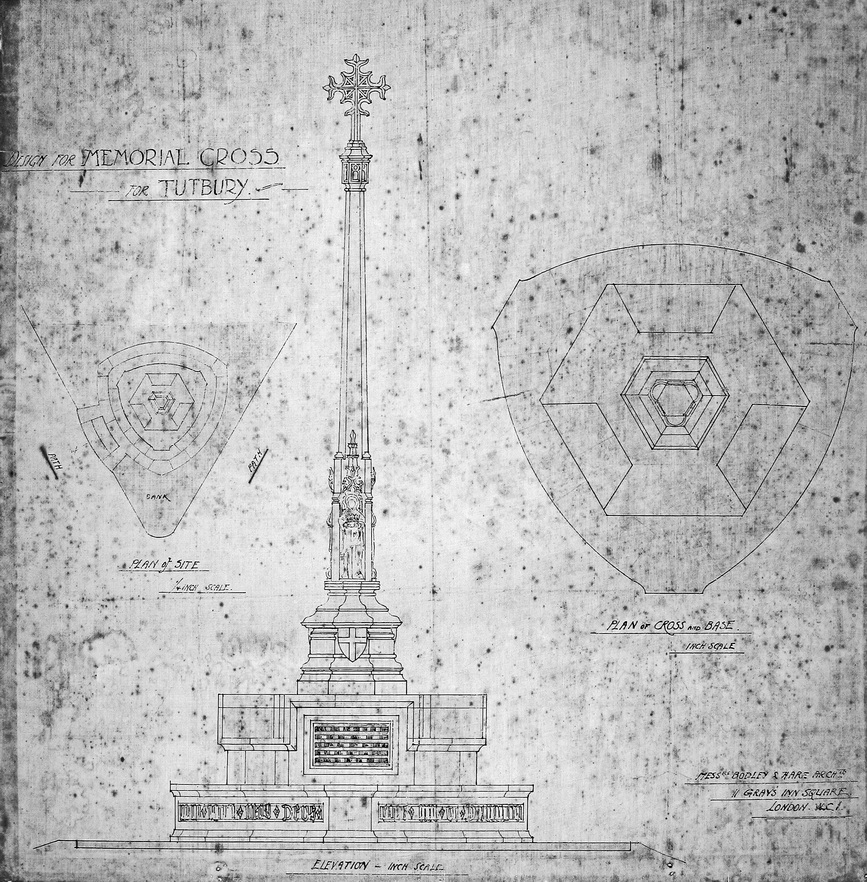Memorial to the Fallen
From the Burton Chronicle, 19 December 1918:
Memorial to the Fallen
The first meeting of the above Committee concerned with this matter was held at the Oddfellows Hall on Monday evening when Major H L Newton, DSO, presided. A collection committee was appointed and a district allocated to each collector. The following sub-
Major H L Newton, Chairman
Mrs H Newton
Mrs S Walker
Rev H Bennett
Rev J Charles
Mr F A Ashton (?)
Mr G L White
Mr S A Lester as secretary.
It was mentioned that the number of fallen from the parish was 42 and already a donation of £20 had been promised.
Bodley & Hare (Gray’s Inn Square, London – 1907- n[1].
n[1].
The description of the War Memorial on the War Memorials Archive (Imperial War Museum) is‘Foliated sandstone cross on six faceted tapering pillar. Shields in relief. Three figures: female angel, St. George and St. Michael.’
In the Lady Chapel there is a framed architectural drawing of the Memorial, resting on the floor, which will need conservation and protection. Click on the picture right for a larger view (Ref: 20210210 1743A2)
The Burton Chronicle of 6th May 1920 recorded the dedication of the War Memorial:
Dedication of War Memorials
A large congregation assembled at the Parish Church on Sunday[2] afternoon to witness the dedication of the war memorials. The first part of the service was held in the church, where the Bishop of Stafford dedicated a beautiful stained glass window, erected in the south aisle, and a tablet containing the names of the forty-
The congregation then moved into the churchyard, where another large assembly had gathered on the southern side of the church to witness the dedication of the new parish memorial, a handsome stone cross beautifully carved in Hollington[3] stone by Messrs. Bridgeman and Son, of Lichfield to the design of Mesrts. {sic} Bodley and Hare of London. Amongst those waiting were a large company of ex-
The ex-
The Rev. J. Charles, pastor of the Congregational church, read the lesson, which was taken from Wisdom iii., and the following names of the fallen were read: William E. Priestly, John J. Kidd, Ernest Woodall, Ernest Plumb, Robert Radford, William Gent, Charles Bull, James Worrall, George E. Bentley, Wilfren {sic} Powell, Frederick Bannister, W. Trafford Newton, George F. Bennett, Charles Bond, Tom Merrey, Thomas Coates, James Nash, Arthur Treadwell, Edwin Powell, William Cook, Joseph Talbot, William Bentley, Frederick Bennett, Samuel Woodal {sic}, George Causer, Abraham Farmer, Eric Dunicliffe, Stephen Leedham, William Hinds, James Hand, William Smith, Edwin Broughton, William Wheeldon, Albert Timmins, Ernest A. Perkins, George Fearn, Joseph Pegg, Jack Leadbetter, Alfred Brettell, Samuel Wheat, William H. Parker, Harry Allsop, David Bond, Frederick Smith, Ogden Pateman, E. Frank Hadland, Alfred J. Parker.
The ceremony of the unveiling of the memorial was then performed by Major H. L. Newton, D.S.O. Under the figure of Peace, a bronze tablet was shown, bearing the inscription, “In grateful memory of Tutbury men who gave their lives in their country’s defence, 1914-
After the Bishop had dedicated the memorial, the reveille was sounded by Mr. Bell, followed by the singing of “The King of Love my Shpeherd {sic} is.” From the text “God forbid that I should glory save in the cross of Jesus Christ.” his Lordship gave a splendid address, in which he spoke most touchingly of the noble sacrifice of the men. He asked his hearers to ever remember their brave deeds, and spoke of the value of memorials to keep these men and their unselfish acts fresh in our memories. The Hymn “They whose course is o’er” was then sung, and after the Bishop had pronounced the Benediction, the National Anthem was sung as a conclusion to the service. The singing for the service was lead by the choir, under Mr. C. Owen, organist and choirmaster.
A large number of floral tributes was placed on the memorial at the conclusion and on the front was placed a large laurel wreath. Amongst those who placed tributes were relatives and friends of the fallen.
We have not been able to find any record of the criteria for inclusion of men on the Memorial and some men do appear on more than one local War Memorial, showing the close nature of villages in this area.
The names appear to be recorded on the Memorial in order of the date of their death and no rank, unit or decorations are shown, symbolising the equality of sacrifice of all casualties. This is in keeping with the edict from the first meeting of the (then) Imperial War Graves Commission in 1917 which decreed that ‘in the erection of memorials and graves there should be no distinction between officers and men’; further it was agreed that there should be ‘no distinction between creed and nationality’. Both of these were radical departures from what had gone before.
Footnotes
[1] Pamphlet “The Priory Church of St. Mary the Virgin, Tutbury, Staffordshire” (Author T.J. Ganz, Vicar).
[2] The dedication was on Sunday 2nd May 1920
[3] Hollington Stone: available in Red, Mottled, Cream from Hollington, Staffordshire ST10 4HQ
[4] N.F.D and D.S and S.: The National Federation of Discharged and Demobilized Sailors and Soldiers was founded in January 1917 by London-
[5] K.R.R: King’s Royal Rifle Corps

